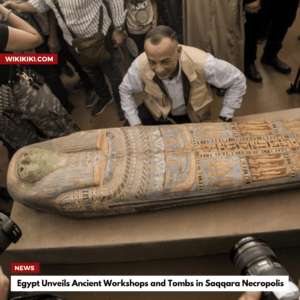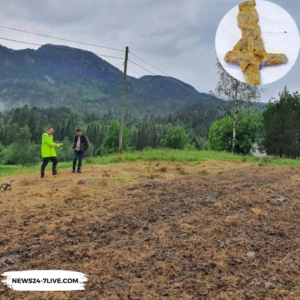Egyptian antiquities authorities have revealed the discovery of ancient workshops and tombs in the Pharaonic necropolis of Saqqara, located just outside the capital city of Cairo. Saqqara is a significant part of Egypt’s ancient capital of Memphis, recognized as a UNESCO World Heritage site. The newly uncovered spaces shed light on the mummification practices of both humans and sacred animals and date back to the 30th Pharaonic Dynasty (380 BCE to 343 BCE) and the Ptolemaic period (305 BCE to 30 BCE).
Also Read: The 2,000-Year-Old Roman Carvings Discovered in Spain

The workshops found in Saqqara were dedicated to the mummification process, involving both humans and animals. Mostafa Waziri, the secretary-general of the Supreme Council of Antiquities, stated that the workshops consist of rooms with stony beds where the deceased were laid down for mummification. Each bed, measuring two meters in length and 50 cm in width, was covered with plaster and equipped with gutters. Archaeologists discovered clay pots and other items used in mummification within the workshops, along with ritual vessels.
Tombs of Prominent Officials
The tombs unearthed at the site belonged to prominent individuals from different periods of ancient Egypt. According to Sabri Farag, the head of the Saqqara archaeological site, one tomb belonged to “Ne Hesut Ba,” a top official from the Old Kingdom of ancient Egypt who served as the head of scribes and priest of the gods Horus and Maat. The tomb walls were adorned with depictions of daily life, agriculture, and hunting scenes.
The second tomb belonged to a priest named “Men Kheber” from the 18th Dynasty. Carved into rock, the tomb showcased depictions of the deceased, both on the walls and in a one-meter-long alabaster statue. The tomb’s decorations included scenes depicting the deceased in various positions before offering tables. Additionally, a collection of ushabti figurines was discovered within the tomb.
Also Read: New Dinosaur Species Reveals Clues about Spinosaurus History
Recent Discoveries in Saqqara Necropolis
In recent years, Egypt’s government has actively promoted and shared new archaeological finds with the international media and diplomats. By doing so, they aim to attract more tourists to the country and revitalize the tourism industry, which suffered setbacks due to political turmoil following the 2011 uprising. These significant discoveries in Saqqara further contribute to Egypt’s cultural heritage and offer insights into ancient Egyptian practices, attracting visitors interested in exploring the rich history and archaeological wonders of the region.
Significance of the Discoveries in Saqqara Necropolis
The recent discoveries in Saqqara add to the growing body of knowledge about ancient Egyptian culture and civilization. Unearthing mummification workshops provides a deeper understanding of the embalming process and the rituals associated with it. The artifacts found within these workshops, such as clay pots and ritual vessels, offer valuable insights into the material culture of the time.
Furthermore, the tombs of prominent officials shed light on the roles and responsibilities of individuals in ancient Egyptian society. The depictions on the tomb walls provide glimpses into the daily lives, religious beliefs, and social activities of these individuals. The discoveries contribute to our understanding of the hierarchical structure, religious practices, and artistic expressions of ancient Egypt.
Efforts to Revive Tourism
Egypt’s tourism and antiquities ministry has been working diligently to revive the country’s tourism sector. The government launched a strategy with the goal of achieving a rapid increase in inbound tourism at a rate of 25-30 percent annually. Minister Ahmed Issa emphasized the aim of drawing in 30 million tourists per year by 2028, a significant increase from the pre-pandemic figure of 13 million. One of the key components of this strategy is the long-awaited inauguration of the Grand Egyptian Museum, located near the pyramids in Giza.
Also Read: The Impact of Rising Ocean Temperatures on Marine Life
Overview
The recent archaeological discoveries in the Saqqara necropolis highlight the rich historical heritage of Egypt. The mummification workshops and tombs provide valuable insights into the embalming practices and the lives of prominent officials from different dynasties. Egypt’s efforts to promote these discoveries to a global audience demonstrate the country’s commitment to revitalizing its tourism industry.
By preserving and showcasing its ancient treasures, Egypt continues to position itself as a premier destination for cultural and historical tourism. The findings in Saqqara not only contribute to our understanding of ancient Egyptian civilization but also create a sense of awe and fascination for visitors from around the world.
These archaeological discoveries serve as a reminder of the enduring legacy of Egypt’s past and the remarkable achievements of its ancient civilization. The meticulous craftsmanship displayed in the mummification workshops and the intricate artwork found in the tombs demonstrate the advanced skills and cultural sophistication of the people who lived thousands of years ago.
For tourists and history enthusiasts, exploring the Saqqara necropolis offers a captivating journey through time. It provides a unique opportunity to walk in the footsteps of pharaohs, priests, and skilled artisans, gaining a deeper appreciation for their achievements and contributions to human history.
Moreover, the unveiling of these ancient workshops and tombs is not only significant for Egypt but also for the field of archaeology. Each new discovery adds another piece to the puzzle of ancient Egyptian civilization, allowing researchers to refine their understanding of the past and challenge existing theories. The meticulous documentation and preservation of these sites ensure that future generations will have the chance to study and appreciate them.
As Egypt continues to invest in the preservation and promotion of its cultural heritage, the country is poised to reclaim its position as a top tourist destination. The combination of iconic landmarks such as the Pyramids of Giza and the temples of Luxor, along with these recent archaeological discoveries, creates a compelling narrative that entices travelers to embark on a journey of discovery and exploration.
In conclusion, the unveiling of ancient workshops and tombs in the Saqqara necropolis represents a remarkable achievement in Egypt’s ongoing efforts to showcase its rich historical legacy. These discoveries not only deepen our understanding of ancient Egyptian civilization but also provide a captivating experience for tourists seeking to immerse themselves in the wonders of the past. As Egypt embraces its archaeological treasures, it invites the world to witness the splendor of its ancient heritage and contribute to the ongoing narrative of human history.
Also Read: Mona Lisa Painting: Italian Historian Solved the Mystery of the Bridge



















+ There are no comments
Add yours